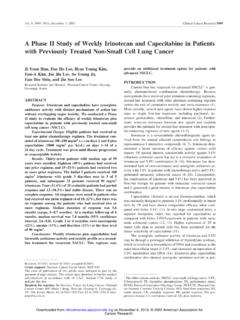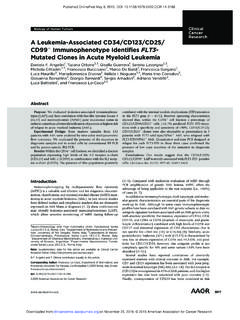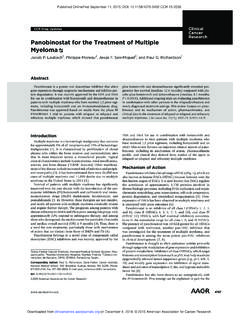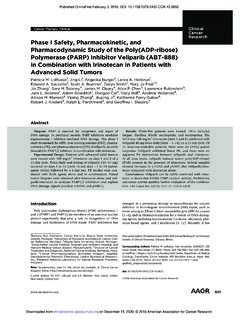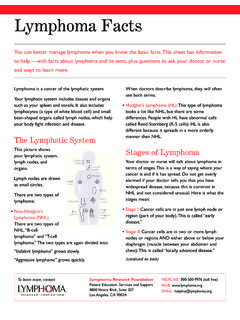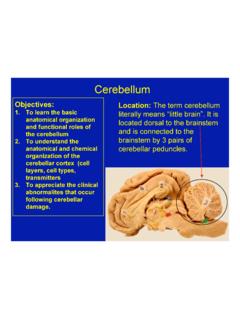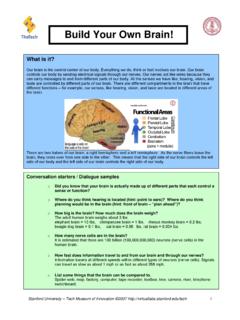Transcription of Molecular Pathways: Activating T Cells after Cancer Cell ...
1 Published OnlineFirst June 26, 2015; DOI: Molecular Pathways Clinical Cancer Research Molecular Pathways: Activating T Cells after Cancer Cell Phagocytosis from Blockade of CD47. "Don't Eat Me" Signals Melissa N. McCracken1,2,3, Adriel C. Cha1,2,3,4, and Irving L. Weissman1,2,3,5. Abstract Recent advances with immunotherapy agents for the treat- innate Cells are also professional antigen-presenting Cells ment of Cancer have provided remarkable, and in some cases, (APC), providing a link from innate to adaptive antitumor curative results. Our laboratory has identi ed CD47 as an immunity. Preliminary studies have demonstrated that APCs important "don't eat me" signal expressed on malignant Cells .
2 Present antigens from phagocytosed tumor Cells , causing T-cell Blockade of the CD47:SIRP-a axis between tumor Cells and activation. Therefore, agents that block the CD47:SIRP-a innate immune Cells (monocytes, macrophages, and dendritic engagement are attractive therapeutic targets as a monotherapy Cells ) increases tumor cell phagocytosis in both solid tumors or in combination with additional immune-modulating agents (including, but not limited to, bladder, breast, colon, lung, and for Activating antitumor T Cells in vivo. Clin Cancer Res; 21(16);. pancreatic) and hematologic malignancies. These phagocytic 3597 601. 2015 AACR. Background but if the tumor Cells are expressing CD47, it can bind with signal regulatory protein-a (SIRP-a) on phagocytic immune Cells , pre- Tumors are able to evade immune recognition and removal venting engulfment (Fig.)
3 1; refs. 4, 6 8). CD47:SIRP-a engage- through multiple processes, including creating an immunosup- ment results in activation of SIRP-a by which phosphorylation of pressive environment, or direct tumor immune cell interactions immunoreceptor tyrosine-based inhibition (ITIM) motifs leading (1 4). One mechanism to avoid removal by innate immune Cells to the recruitment of Src homology phosphatase-1 (SHP-1) and (macrophages and dendritic Cells ) is to upregulate "don't eat me". SHP-2 phosphatases preventing myosin-IIA accumulation at the signals preventing phagocytosis (5). In addition to preventing phagocytic synapse preventing phagocytosis (Fig.
4 1; ref. 9). This programed cell removal (PrCR) by reducing total phagocytosis, inhibitory mechanism of CD47 expression is seen in a broad antigen presentation from innate to adaptive immune Cells is range of malignancies and is therefore an attractive therapeutic limited, thereby restricting the cross-presentation to the adaptive target for all tumors expressing CD47 (5, 6, 10 22). In preclinical immune Cells (1, 4). As a result, immunotherapies that increase models, disruption of the CD47:SIRP-a axis results in enhanced tumor cell recognition by innate immune Cells should also act as phagocytosis, tumor reduction, and has recently been demon- stimulation to the adaptive immune response in vivo.
5 Strated to be a means to cross-present tumor antigens to T Cells (Fig. 1; refs. 11, 15). To date, several strategies to block the CD47:SIRP-a inter- CD47 a "don't eat me" signal on Cells action have been developed, including antibodies or antibody CD47, a transmembrane protein found ubiquitously expressed fragments against CD47 or SIRP-a (6, 19, 23), small peptides on normal Cells to mark "self," has increased expression in that bind CD47 or SIRP-a (12, 16), or systemic knockdown of circulating hematopoietic stem Cells (HSC), red blood Cells CD47 expression (6, 15, 21). One advantage of antibodies that (RBC), and a high proportion of malignant Cells (4, 5).
6 Although target CD47 is the increase in antibody-dependent cellular CD47 has multiple functions in normal cell physiology, in Cancer phagocytosis (ADCP), which occurs when innate immune Cells it acts primarily as a dominant "don't eat me" signal (Fig. 1;. (macrophages and dendritic Cells ) and Fcg receptors (FcgR). refs. 4, 5). On tumor Cells , prophagocytic signals may be present, bind to the Fc portion of the anti-CD47 antibody (6, 24, 25). To further increase ADCP, anti-CD47 combination with addition- 1. Institute for Stem Cell Biology and Regenerative Medicine, Stanford al tumor-targeting antibodies has been tested preclinically and University School of Medicine, Stanford, California.
7 2 Ludwig Center for shown strong synergy in reducing total tumor burden in mice Cancer Stem Cell Research and Medicine, Stanford University School of Medicine, Stanford, California. 3 Stanford Cancer Institute, Stanford (6, 12, 16, 18). The majority of these studies have been University School of Medicine, Stanford, California. 4 Institute of Bio- performed in NSG mice, which contain innate immune Cells , medical Studies, Baylor University, Waco, Texas. 5 Department of but lack T Cells , B Cells , and natural killer (NK) Cells . NK Cells are Pathology, Stanford University Medical Center, Stanford, California. the dominant Cells responsible for antibody-dependent cell- Corresponding Author: Irving L.
8 Weissman, Institute for Stem Cell Biology mediated cytotoxicity (ADCC), as a result the effects of NK. and Regenerative Medicine, 265 Campus Drive, Stanford, CA 94305. Phone: Cells after anti-CD47 treatment are not well studied (6, 26). 650-723-6520; Fax: 650-498-4034; E-mail: Consequently, only a limited number of studies have investi- doi: gated how CD47:SIRP-a blockade primes the adaptive immune 2015 American Association for Cancer Research. response in immunocompetent systems. 3597. Downloaded from on March 28, 2019. 2015 American Association for Cancer Research. Published OnlineFirst June 26, 2015; DOI: McCracken et al. MHC class I. Tumor cell Macrophage MHC class I.
9 Eat me . CD47. SIRP-a MHC class II. SHP-1/2. Macrophage Tumor cell Tumor cell Macrophage Tumor cell Tumor cell Costimulatory MHC:TCR Tumor Tumor cell peptides cytotoxicity on MHC. T cell T cell T cell T-cell proliferation 2015 American Association for Cancer Research Figure 1. Tumor Cells display MHC class I, surface markers of "self," antiphagocytic "don't eat me," and phagocytic "eat me" signals. Engagement of tumor Cells CD47. ("don't eat me" signal) with macrophages SIRP-a causes activation and phosphorylation of SIRP-a ITIM motifs and the recruitment of SHP-1 and SHP-2. phosphatases preventing myosin-IIA accumulation at the phagocytic synapse inhibiting tumor cell phagocytosis.
10 By blocking the CD47:SIRP-a engagement with antibodies (or alternate strategies) an increase in tumor cell phagocytosis by APCs is observed. The engulfed tumor Cells are then processed, and tumor-associated antigens are presented by these APCs on their MHC. Na ve tumor reactive T Cells can then engage with MHC on APCs presenting tumor neoantigens with additional costimulatory molecules. These tumor-speci c T Cells are then activated, expand, and are able to cause antigen-speci c tumor cell cytotoxicity on remaining malignant Cells . Activating adaptive antitumor immunity in vivo (1, 3, 27). TCR/MHC recognition as well as engagement of Activation of the adaptive immune system, T Cells and B Cells , additional costimulatory molecules occurs between the T cell/.
